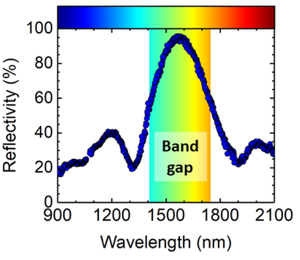Jan 27 2020
A crystal that includes a “3D photonic band gap” can prove to be a robust tool for manipulating light. Such as crystal could be very beneficial for new types of sensors, solar cells, and miniature lasers. A wide spectrum of light wavelengths is forbidden within such a man-made crystal.
 Band gap between wavelengths of 1400 nm and 1750 nm. Image Credit: University of Twente.
Band gap between wavelengths of 1400 nm and 1750 nm. Image Credit: University of Twente.
Theoretical models have so far been used to determine the characteristic wavelength region. Idealized models such as these have evident drawbacks. Scientists from the University of Twente (MESA+) have now devised a fully experimental technique to determine the band gap, revealing exactly what is unknown. The study outcomes have been reported in Optics Express, published by The Optical Society of America.
Photonic crystals offer fascinating new ways to control light using silicon. This material in itself is not useful to manipulate light. This is because it is transparent for the colors of light employed in telecommunication. Thanks to the unique structure of photonic crystals, various wavelengths of light passing through then are forbidden, thus augmenting the manipulation of light in silicon and enabling the association of photonics and electronics.
Developing these crystals with the preferred “signature” involves nanoscale fabrication, resulting in an arrangement of pores that is perfectly periodic. Yet, what is the outcome? How do the size of pores and “forbidden range” match? In general, theory and simulations start with certain assumptions. For instance, it is just not feasible to add all fabrication disorders.
Thus, researchers from the University of Twente opted for a fully experimental technique, thereby offering valuable feedback to the process of design and fabrication. They achieved this by fabricating 3D photonic crystals that had a band gap in the wavelength range often used in telecommunication, also known as “inverse woodpile” structures.
The researchers can quantify the reflectivity by shining light of a wide bandwidth on it over several angles of incidence, thus finding the exact range that is forbidden. They perform this for two polarizations of the input light, perpendicular to one another.
It is necessary for the photonic band gap width to be the same for both polarizations, which is validated by the measurements. High-quality crystals must exhibit more than 90% of reflectivity in the forbidden band: this is also validated by the experiments.
The new probe method can be used to quickly assess the quality of a photonic crystal, thus enabling the fabrication process to easily adjusted for new and difficult applications in optoelectronics and quantum photonics.
The study was conducted in the Complex Photonics Group of the MESA+ Institute at the University of Twente. It is supported by the Dutch Research Council NWO (the “Free Form Scattering Optics” and “Stirring of Light” programs) and the “Applied Nanophotonics” section of the MESA+ Institute.
The study titled “Experimental probe of a complete 3D photonic band gap,” by Manashee Adhikary, Ravitej Uppu, Cornelis Harteveld, Diana Grishina, and Willem Vos, was published in Optics Express.